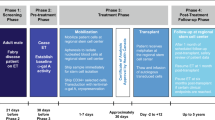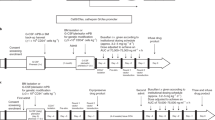Abstract
Autologous transplantation of retrovirally transduced bone marrow (BM) or neonatal blood cells was carried out on eight cats (ranging in age from 2 weeks to 12 months) with mucopolysaccharidosis type VI (MPS VI). The transducing vector contained the full-length cDNA encoding human arylsulfatase B (hASB), the enzymatic activity deficient in this lysosomal storage disorder. Following transplantation, the persistence of transduced cells and enzymatic expression were monitored for more than 2 years. Five of the cats received no myeloablative preconditioning, two cats received 370–390 cGy of total body irradiation (TBI), and one cat received 190 cGy TBI. Evidence of transduced cells, as judged by enzymatic activity and PCR detection of the provirus, was demonstrated in granulocytes, lymphocytes, or BM cells of the treated animals up to 31 months after transplantation. Radiation preconditioning was not required to achieve these results, nor were they dependent on the recipient’s age. However, despite the long-term persistence of transduced cells, the levels of ASB activity in the transplanted animals was low, and no clinical improvements were detected. These data provide evidence for the long-term persistence of retrovirally transduced feline hematopoietic cells, and further documentation that engraftment of transduced cells can be achieved in the absence of myeloablation. Consistent with previous bone marrow transplantation studies, these results also suggest that to achieve clinical improvement of MPS VI, particularly in the skeletal system, high-level expression of ASB must be achieved in the treated animals and improved techniques for targeting the expressed enzyme to specific sites of pathology (eg chondrocytes) must be developed.
This is a preview of subscription content, access via your institution
Access options
Subscribe to this journal
Receive 12 print issues and online access
$259.00 per year
only $21.58 per issue
Buy this article
- Purchase on Springer Link
- Instant access to full article PDF
Prices may be subject to local taxes which are calculated during checkout



Similar content being viewed by others
References
Neufeld EF, Muenzer J . The mucopolysaccharidoses. In: Scriver CR, Beaudet AL, Sly WS, Valle D (eds) The Metabolic and Molecular Bases of Inherited Disease McGraw-Hill: New York 1995 2465–2494
Jezyk P, Haskins ME, Patterson DF . Mucopolysaccharidosis in a cat with arylsulfatase B deficiency: a model of Maroteaux–Lamy syndrome Science 1977 198: 834–836
Neer TM et al. A clinical vignette. Mucopolysaccharidosis VI (Maroteaux–Lamy syndrome) in a miniature pinscher J Vet Int Med 1997 6: 429–431
Yoshida M et al. Arylsulfatase B-deficient mucopolysaccharidosis in rats J Clin Invest 1993 91: 1099–1104
Krivit W et al. Bone-marrow transplantation in the Maroteaux–Lamy syndrome (mucopolysaccharidosis type VI) New Engl J Med 1984 311: 1606–1611
McGovern MM et al. Bone marrow transplantation in Maroteaux–Lamy syndrome (mps type 6): status 40 months after BMT Birth Defects 1986 22: 41–53
Crawley AC et al. Enzyme replacement therapy from birth in a feline model of mucopolysaccharidosis type VI J Clin Invest 1997 99: 651–662
Gasper PW et al. Correction of feline arylsulfatase B deficiency (mucopolysaccharidosis VI) by bone marrow transplantation Nature 1984 312: 467–469
Wenger DA et al. Bone marrow transplantation in the feline model of arylsulfatase B deficiency Birth Defects 1986 22: 177–186
Norrdin RW, Moffat KS, Thrall MA, Gasper PW . Characterization of osteopenia in feline mucopolysaccharidosis VI and evaluation of bone marrow transplantation therapy Bone 1993 14: 361–367
Simonaro CM et al. Bone marrow transplantation in newborn rats with mucopolysaccharidosis type VI Transplantation 1997 63: 1386–1393
Hoogerbrugge PM et al. Allogeneic bone marrow transplantation for lysosomal storage diseases Lancet 1995 345: 1398–1402
Fraser CC, Szilvassy SJ, Eaves CJ, Humphries RK . Proliferation of totipotent hematopoietic stem cells in vitro with retention of long-term competitive in vivo reconstiuting ability Cell Biol 1992 89: 1968–1972
Correll PH, Colilla S, Karlsson SA . Retroviral vector design for long-term expression in murine hematopoietic cells in vivo Blood 1994 84: 1812–1822
Brenner MK . Gene transfer to hematopoietic cells New Engl J Med 1996 335: 337–339
Brenner MK, Cunningham JM, Sorrentino BP, Heslop HE . Gene transfer into hematopoietic progenitor cells Br Med Bull 1995 51: 167–191
Carter RF et al. Autologous transplantation of canine long-term marrow culture cells genetically marked by retroviral vectors Blood 1992 79: 356–364
Bienzle D et al. Gene transfer into hematopoietic stem cells: long-term maintenance of in vitro activated progenitors without marrow ablation Proc Natl Acad Sci USA 1994 91: 350–354
Scaradavou A et al. A murine model for human cord blood transplantation: near-term fetal and neonatal peripheral blood cells can achieve long-term bone marrow engraftment in sublethally irradiated adult recipients Blood 1998 89: 1089–1099
Fillat C et al. Arylsulfatase B activities and glycosaminoglycan levels in retrovirally transduced mucopolysaccharidosis VI cells: prospects for gene therapy J Clin Invest 1996 98: 497–502
Brooks DA et al. Enzyme replacement therapy in mucopolysaccharidosis VI: evidence for immune responses and altered efficacy of treatment in animal models Biochem Biophys Acta 1997 1361: 203–216
Barquinero J et al. Myelosuppressive conditioning improves autologous engraftment of genetically marked hematopoietic repopulating cells in dogs Blood 1995 85: 1195–1201
Kurtzberg J et al. The use of umbilical cord blood in mismatched related and unrelated hemopoietic stem cell transplantation Blood Cells 1994 20: 275–283
Asch J et al. Retroviral gene transfer into cord blood stem/progenitor cells using purified vector stocks Am J Hematol 1998 57: 16–23
Kohn D et al. Engraftment of gene-modified umbilical cord blood cells in neonates with adenosine deaminase deficiency Nature Med 1995 1: 1017–1023
Hoogerbrugge PM et al. Bone marrow gene transfer in three patients with adenosine deaminase deficiency Gene Therapy 1996 3: 179–183
Beratis NG, Turner BM, Weiss R, Hirshhorn K . Arylsulfatase B deficiency in Maroteaux–Lamy syndrome: cellular studies and carrier identification Pediatr Res 1975 9: 475–480
Huang MH et al. Retrovirus-mediated transfer of the human α-iduronidase cDNA into human hematopoietic progenitor cells leads to correction in trans of Hurler fibroblasts Gene Therapy 1997 4: 1150–1159
Author information
Authors and Affiliations
Rights and permissions
About this article
Cite this article
Simonaro, C., Haskins, M., Abkowitz, J. et al. Autologous transplantation of retrovirally transduced bone marrow or neonatal blood cells into cats can lead to long-term engraftment in the absence of myeloablation. Gene Ther 6, 107–113 (1999). https://doi.org/10.1038/sj.gt.3300797
Received:
Accepted:
Published:
Issue Date:
DOI: https://doi.org/10.1038/sj.gt.3300797
Keywords
This article is cited by
-
Neonatal umbilical cord blood transplantation halts skeletal disease progression in the murine model of MPS-I
Scientific Reports (2017)
-
Neonatal cellular and gene therapies for mucopolysaccharidoses: the earlier the better?
Journal of Inherited Metabolic Disease (2016)
-
Myeloablation enhances engraftment of transduced murine hematopoietic cells, but does not influence long-term expression of the transgene
Gene Therapy (2002)
-
Articular Chondrocytes from Animals with a Dermatan Sulfate Storage Disease Undergo a High Rate of Apoptosis and Release Nitric Oxide and Inflammatory Cytokines: A Possible Mechanism Underlying Degenerative Joint Disease in the Mucopolysaccharidoses
Laboratory Investigation (2001)
-
Hematopoietic stem cell gene therapy leads to marked visceral organ improvements and a delayed onset of neurological abnormalities in the acid sphingomyelinase deficient mouse model of Niemann–Pick disease
Gene Therapy (2000)



